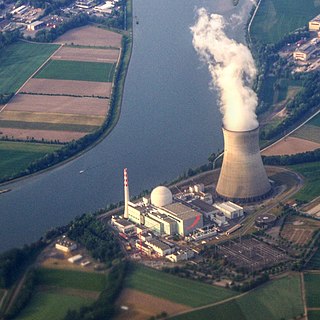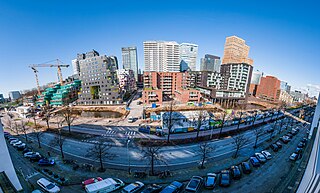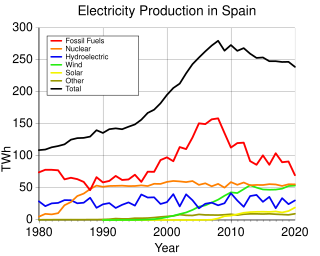
Nuclear power is the use of nuclear reactions to produce electricity. Nuclear power can be obtained from nuclear fission, nuclear decay and nuclear fusion reactions. Presently, the vast majority of electricity from nuclear power is produced by nuclear fission of uranium and plutonium in nuclear power plants. Nuclear decay processes are used in niche applications such as radioisotope thermoelectric generators in some space probes such as Voyager 2. Generating electricity from fusion power remains the focus of international research.

The economy of the Netherlands is a highly developed market economy focused on trade and logistics, manufacturing, services, innovation and technology and sustainable and renewable energy. It is the world's 18th largest economy by nominal GDP and the 28th largest by purchasing power parity (PPP) and is the fifth largest economy in European Union by nominal GDP. It has the world's 11th highest per capita GDP (nominal) and the 13th highest per capita GDP (PPP) as of 2023 making it one of the highest earning nations in the world. Many of the world's largest tech companies are based in its capital Amsterdam or have established their European headquarters in the city, such as IBM, Microsoft, Google, Oracle, Cisco, Uber, Netflix and Tesla. Its second largest city Rotterdam is a major trade, logistics and economic center of the world and is Europe's largest seaport. Netherlands is ranked fifth on global innovation index and fourth on the Global Competitiveness Report.

A nuclear power phase-out is the discontinuation of usage of nuclear power for energy production. Often initiated because of concerns about nuclear power, phase-outs usually include shutting down nuclear power plants and looking towards fossil fuels and renewable energy. Three nuclear accidents have influenced the discontinuation of nuclear power: the 1979 Three Mile Island partial nuclear meltdown in the United States, the 1986 Chernobyl disaster in the USSR, and the 2011 Fukushima nuclear disaster in Japan.
Nuclear decommissioning is the process leading to the irreversible complete or partial closure of a nuclear facility, usually a nuclear reactor, with the ultimate aim at termination of the operating licence. The process usually runs according to a decommissioning plan, including the whole or partial dismantling and decontamination of the facility, ideally resulting in restoration of the environment up to greenfield status. The decommissioning plan is fulfilled when the approved end state of the facility has been reached.
As of 2022, nuclear power is provided by six commercial nuclear power plants in Pakistan. Pakistan is the first Muslim majority country in the world to construct and operate civil nuclear power plants. The Pakistan Atomic Energy Commission (PAEC), the scientific and nuclear governmental agency, is solely responsible for operating these power plants. As of 2018, the electricity generated by commercial nuclear power plants constitutes roughly 7.5% of electricity generated in Pakistan, Pakistan is not a party to the Nuclear Non-Proliferation Treaty but is a member of the International Atomic Energy Agency. Pakistan plans on constructing 32 nuclear power plants by 2050 and envisions 40,000 MW of nuclear power generation.

The Borssele Nuclear Power Station is a nuclear power plant near the Dutch town of Borssele. It has a pressurised water reactor (PWR). Borssele is the only nuclear power plant still operational for electricity production in the Netherlands. Its net output is 485 MWe.

Dodewaard nuclear power plant was a nuclear power plant with a 55 MWe boiling water reactor (BWR) of General Electric in the Dutch town of Dodewaard. The plant halted energy production in 1997. Its final decommissioning has been postponed for a period of 40 years and was placed into a safe enclosure configuration in 2005.

Nuclear power construction costs have varied significantly across the world and in time. Large and rapid increases in cost occurred during the 1970s, especially in the United States. Recent cost trends in countries such as Japan and Korea have been very different, including periods of stability and decline in costs.
Nuclear power in Switzerland is generated by three nuclear power plants, with a total of four operational reactors (see list below). Nuclear power has contributed a steady fraction of around forty percent to the Swiss electricity production since 1985. In 2022, it produced 23 terawatt-hours (TWh) of electricity, and accounted for 37% of the nation's gross electricity generation of 62 TWh, while 55% was produced by hydroelectric plants and 8% came from conventional thermal power stations and non-hydro renewable energy sources.

Obninsk Nuclear Power Plant was built in the "Science City" of Obninsk, Kaluga Oblast, about 110 km (68 mi) southwest of Moscow, Soviet Union. Connected to the power grid in June 1954, Obninsk was the first grid-connected nuclear power plant in the world, i.e. the first nuclear reactor that produced electricity industrially, albeit at small scale. It was located at the Institute of Physics and Power Engineering. The plant is also known as APS-1 Obninsk. It remained in operation between 1954 and 2002. Its production of electricity for the grid ceased in 2002; thereafter it functioned as a research and isotope production plant only.

Spain has five active nuclear power plants with seven reactors producing 21% of the country's electricity as of 2013.
The Kernfysische dienst is the Dutch nuclear regulatory organisation. It is a part of the ministry of Ministry of Economic Affairs (Netherlands).
Nuclear power in the European Union accounted for approximately 26% of total electricity production in 2019 and nearly half of low-carbon energy production across the EU.
National nuclear energy policy is a national policy concerning some or all aspects of nuclear energy, such as mining for nuclear fuel, extraction and processing of nuclear fuel from the ore, generating electricity by nuclear power, enriching and storing spent nuclear fuel and nuclear fuel reprocessing. Nuclear energy policies often include the regulation of energy use and standards relating to the nuclear fuel cycle.
Belgium has two nuclear power plants operating with a net capacity of 5,761 MWe. Electricity consumption in Belgium has increased slowly since 1990 and in 2016 nuclear power provided 51.3%, 41 TWh per year, of the country's electricity.
Lithuania does not have any operational nuclear power reactor. It operated two RBMK reactors at Ignalina Nuclear Power Plant which were shut down in 2004 and 2009.
Currently, Turkey has no operating commercial nuclear reactors. However, four VVER-1200 reactors at the Akkuyu Nuclear Power Plant, are currently under construction and expected to come online in 2023. The government is aiming for 20 GW of nuclear.
Bangladesh first conceived building a nuclear power plant in 1961. The Bangladesh Atomic Energy Commission was established in 1973. The country currently operates a TRIGA research reactor at the Atomic Energy Research Establishment in Savar.
The Malaysian Nuclear Agency never reviews nuclear power as an option to meet the increasing demands of energy in Malaysia. There is a need to build a nuclear power generation plant, with plans still in the feasibility stage.

The Rooppur Nuclear Power Plant (Bengali: রূপপুর পারমাণবিক বিদ্যুৎকেন্দ্র) is a 2.4 GWe nuclear power plant project in Bangladesh. The nuclear power plant is being constructed at Rooppur of Ishwardi upazila in Pabna District, on the bank of the river Padma, 87 miles (140 km) west of Dhaka. It will be the country's first nuclear power plant, and the first of the two units is expected to go into operation in 2024. The VVER-1200/523 Nuclear reactor and critical infrastructures are being built by the Russian Rosatom State Atomic Energy Corporation. In the main construction period, the total number of employees will reach 12,500, including 2,500 specialists from Russia. It is expected to generate around 15% of the country's electricity when completed.









